If you’re looking for a fresh set of short scale bass strings to help you bring the groove on your bass playing, I’ve got just the selection of strings you’re looking for.
I’m primarily a guitar player who plays bass on occasion. To make my life easier, I want my bass playing experience as close to the electric guitar I’m used to as possible. And short scale basses make this possible.
Top 3 - Short Scale Bass Strings
Preview | Product | Price |
|---|---|---|
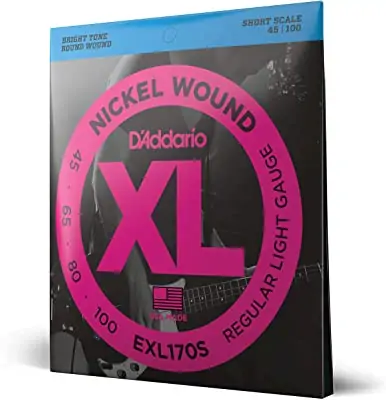 | ||
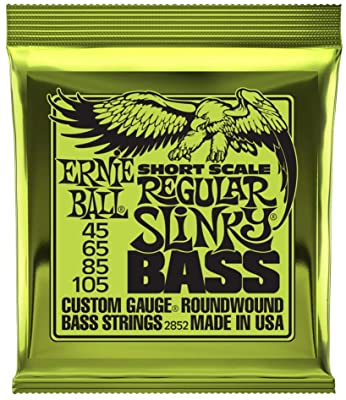 | ||
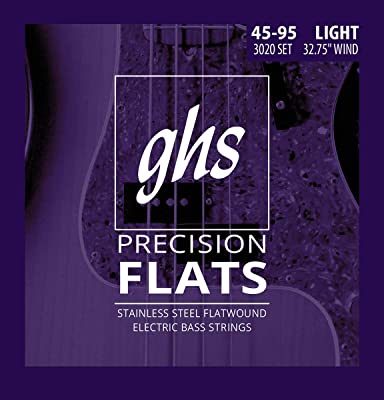 |
5 Best Strings for Short Scale Basses
Without wasting any of your time with bass string basics that you’re already aware of, here are my top picks for the best strings for short scale basses.
1. D'Addario EXL170S
The D’Addario Regular Light strings are one of their most popular bass strings because of their excellent tone, great feel, and affordable price.
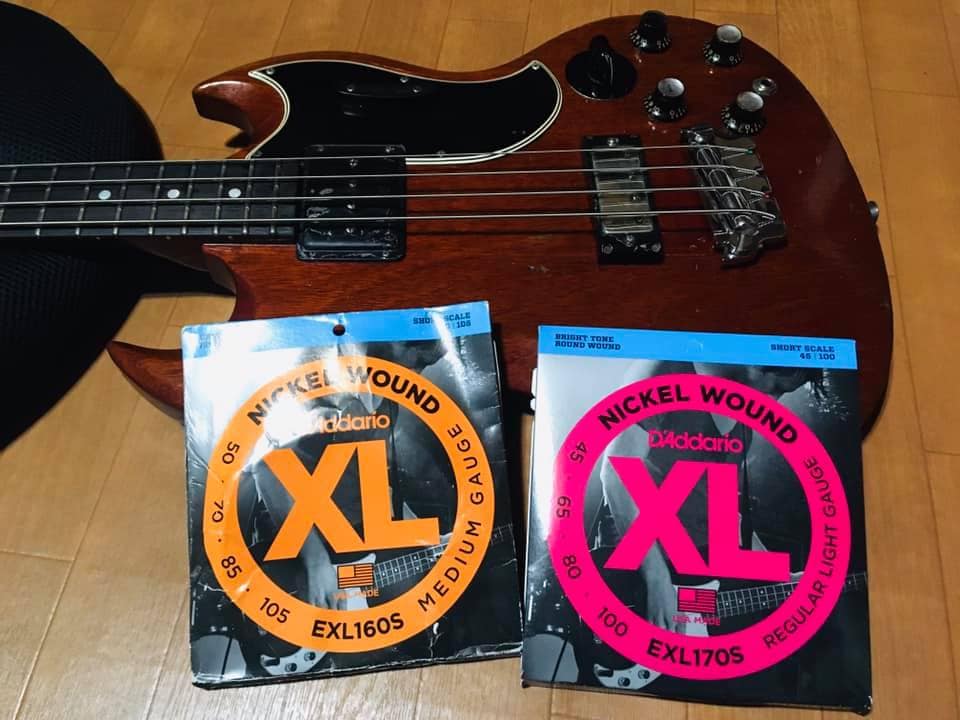
D'Addario EXL170S
These strings have a great high-end. In my testing, I found them to be brighter than most other nickel-plated strings out there. Despite this, they don’t sound as clangy as you might expect.
The strings still have quite a bit of low-end as well, so you’re not missing out on any thumpy punch in your tone. The Regular Lights have an overall balanced tone and perform great in practically any style of music.
This makes them work on nearly any bass as well, which isn’t the case with a lot of other string types and brands. It simply means that you can put them on a Fender P bass and they’ll sound just as good as they would on a Spector.
One thing I have noticed is that these strings tend to lose quite a bit of their brightness after just a few days of consistent playing. The tone doesn’t go flat, it just evens out.
This isn’t going to be a big deal for everyone, but it’s something to keep in mind if you’re considering these specifically for their super bright tone and expecting them to still be very bright after a few weeks.
As for the feel, their nickel plating and round winding made them feel fairly soft on my fingers. It’s a nice-to-have for a set of thick bass strings.
They’re uncoated, but the string cores are treated to make them more resistant to corrosion, making them last longer than other uncoated strings. This works in practice, as I found them to last slightly longer than regular Ernie Balls.
If your bass has a string-through body, you might run into some buzzing. This was especially an issue on the E and A strings in my experience. The strings are tapered, and without enough headroom, they could end up not clearing the first fret, making them hit the bridge and cause buzzing.
PROS
CONS
2. Ernie Ball Regular Slinky
The most popular Ernie Ball strings, the Regular Slinky, are fairly cheap, reliable and sound good, making them an easy pick for most bass players.
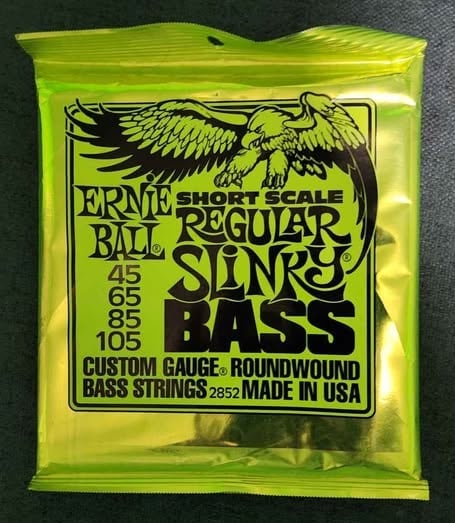
Ernie Ball Short Scale Regular Slinky
The regular slinky strings are probably the most well-known with their nickel wound and tin-plated cores, providing a well-balanced tone that makes them fit in nicely in almost any genre.
They do skew a bit more to the brighter side, so you might be left wanting if you’re looking for a warm sounding set of strings.
I would say they are much better suited for a more modern sound though, and I wouldn’t recommend using them if you’re looking to recreate a vintage tone. But overall, their bright, clear tone is great if you want each note to stand out, like when you’re playing melodies or tapping.
In my experience, the round winding and softer feel along with their fairly light gauge makes for strings that aren’t harsh on your fingers. Their nickel plating also makes them softer on the fretboard, meaning they won’t wear out the fretboard like stainless steel strings.
In my opinion, these qualities make them great set of strings for players of any skill level. Even beginners shouldn’t find them uncomfortable. Ernie Ball strings can seem a bit stiff out of the box, so they might just take a bit longer to break in until they’re at a sweet spot.
They’re uncoated strings, so keep in mind that you’ll have to take a bit of extra care if you want them to last as long as possible. This is especially a big issue for bass players with sweaty hands.
If the regular slinky strings are still a bit too heavy, these same short scale strings also come in a slightly lighter version with the Ernie Ball Super Slinky that is .040 - .100 gauge.
PROS
CONS
3. GHS Precision Flats
The GHS Precision Flats are the ideal strings if you’re trying to nail that vintage jazz sound. I found that they have a fullness and a warmth that really makes your tone stand out and helps to elevate the low end.
The outer wrap is less polished on the GHS Precision Flats, which gives them a more natural and organic feel. They also felt a bit fuller than most flatwound strings I’ve played and their tension is balanced quite evenly across the entire fretboard.
This means that you won’t be dealing with moving from a tense to a loose part of the string as you play. With the fuller feel of the strings, it’s easier to keep your playing as precise as possible.
These strings have a fairly low tension that helps add to their controllability. Bends, vibrato, etc. these are all easier with a lower tension.
The tone is a bit mixed up for my taste, especially on the E string, which can lead to losing some clarity on lower notes.
In my experience, the Precision Flats are better suited to a cleaner sound and make for great strings to play genres like jazz, bossa nova, or any softer styles of music. If you’re looking for great vintage sounding strings, then these strings would definitely be among my top picks.
I wouldn’t recommend using these strings if you’re planning on playing rock and metal, but that doesn’t mean you shouldn’t experiment.
At 32.75-inches, they are slightly longer than normal short scale strings, which gives you a bit more headroom, especially if your bass has a bit more distance that the strings need to cover from anchor to tuning peg (Fender Mustang, for example).
As beginner strings, I think the Precision Flats are a great choice. The low tension and softness of the nickel is a good way for beginners to learn bass without the thick strings being harsh and causing discomfort.
PROS
CONS
4. D’Addario Tapewound Bass Strings
The D’Addario Tapewound strings are a bit more ‘specialized’ than the others. The tapewound strings are made from nylon that produces a very subtle, smooth and warm sound.
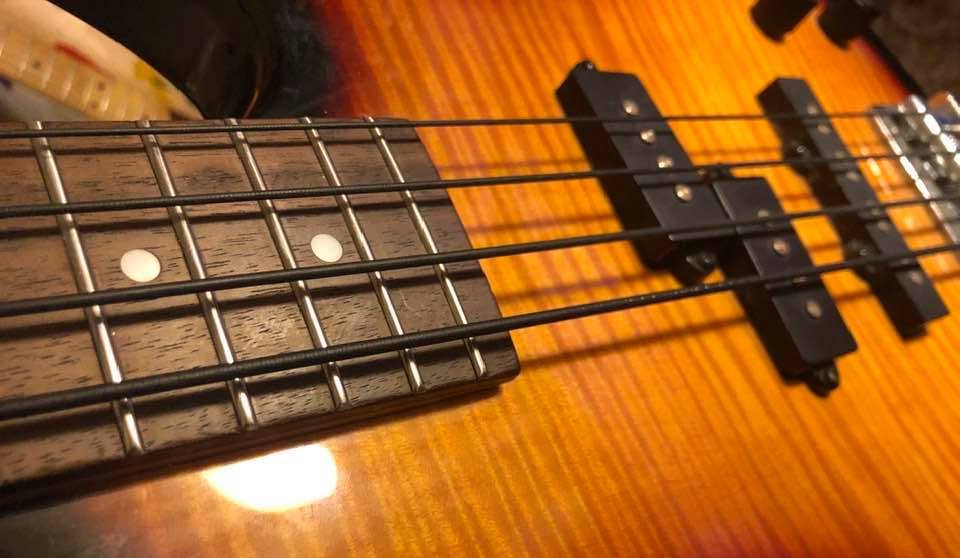
Closer Look at the D'Addario ETB92S Strings
I think the best way to describe their tone would be rich and clear, but slightly dialed down. Overall, their tone is quite dynamic with a flat frequency response. So, you won’t run into any unexpected spikes, especially when recording.
This, along with the tape winding around the strings makes them very soft to the touch and not at all damaging to the fretboard. Apart from providing a soft and smooth tone, finger noise is practically eliminated on tapewound strings.
The tape helps to protect the strings from the elements, making them last a very long time. In the long run, even though these strings are a bit pricier than others, that could actually end up saving you money since you won’t need to restring as often.
That doesn’t mean that they’re very sturdy, however. Nylon isn’t as strong as steel, so you’ll have to be careful not to tune them too tightly or to play too aggressively on these strings.
Moving up a gauge can make them better for harder playing without making them harsher on your fingers though. This can also prevent the need for truss rod and saddle adjustments that sometimes comes with lighter gauge nylon strings. A heavier gauge can also help you get a little bit more pop from the nylon strings.
I’ve found that the tape winding can cause the strings to not fit into the tuning pegs, but simply pulling the tape back a bit solves this problem quite easily.
Just like the GHS Precision Flats, the D’Addario Tapewound strings are perfect for beginners who might be put off by the discomfort that other bass strings can cause.
PROS
CONS
5. Dunlop Nickel Wound
I love the sound of pure nickel strings. There’s a warm, vintage tone and “soft” feel to them that’s hard to capture with other materials.
Of course, nickel wound strings aren’t nearly as durable or as versatile as steel strings, and often you end up with nickel wound strings as a compromise. It’s a best-of-both-worlds situation.
Dunlop’s nickel wound bass strings offer a warm, fat tone that’s apparent as soon as you pluck a few notes through an amp. There’s minimal twang to these bass strings.

How Dunlop themselves describe these strings.
Those looking for '90s grunge style treble-forward tones ought to look elsewhere. However, for a pleasant midrange growl and warm, welcoming tones, these strings are great.
Although these are roundwound strings, and therefore not as soft or slick feeling as flatwounds, I still appreciate the feeling of the nickel winding.
The nickel winding feels softer and slightly less abrasive than steel under your fingers. It’s not the sort of thing that makes a huge difference to most players, but if you’re playing regularly string feel becomes very important.
Some short-scale bass strings lack bass response, ironically enough. This is not at all the issue with these Dunlop strings, which have plenty of punch and thunder on the lower strings.
I tried out a few different bass lines, everything from powerful Motorhead to sweet Billy Ocean and even some “Sweet Emotion.”
With appropriate EQ and technique tweaks, these strings managed to get in the ballpark of the main bass tones I like to emulate.
Of course, bass tone is always more about you as a player. Unless you’re in it for really bright, compressed tones a la Duff McKagan in the '90s, I’d confidently say that you’ll find a sound you like and can use for recordings and gigs with these Dunlop strings.
Make Sure to Buy the Right Length of Strings
One common problem that a lot of bassists run into is buying strings that are too short. This isn’t always the bassist’s fault for just not knowing they need short scale strings, but rather the bass’ scale length is a bit misleading.
Take violin basses as an example, like the Hofner Violin Bass. It is a short scale bass with a 30-inch scale length.

Hofner Violin Bass
The problem, however, is that it has a trapeze tailpiece, meaning that the strings are actually anchored up to 4 inches back from the saddle. With short scale strings normally only being up to 32 inches, that means your strings will be at least 2 inches too short.
The same problem can be caused by basses that have a string-through body where, instead of being anchored to the saddle, the strings are threaded through the body and anchored at the back.
It’s always best to know the scale length of your short scale bass before trying out new strings. You don’t want to take the strings off your bass, only to find that your new packet is too short!
So, before you buy new strings for your bass, the best thing is to measure the old strings so that you know which length strings you need to get.
Simply remove the strings and then measure them from the ball end to where the string goes over the nut. This should give you a good estimate for how long the strings should be. But in most cases, medium scale strings should be enough.
I’ve seen cases where extremely popular short scale strings like Ernie Ball Slinkys don’t fit (aren’t long enough for) basses like Fender Mustang that are marketed as ‘short scale’.
The reason for this is that the term “short scale” is relative, not absolute. Scale length is a situation where a few inches makes a huge difference.
Anyone will tell you that short-scale basses feel totally different from full-sized basses. There’s an appreciable difference in playing experience from one full-scale bass to the next, and the same is similarly true of short-scale basses.
Because the term “short scale” is relative, there are many variations on what short scale means, from one manufacturer to the next and even within one factory.
Some “student sized” basses are simply ¾ length, while others have a short scale closer to that of a standard electric guitar. These are usually aimed at players who switch between guitar and bass in the same live set.
Whatever the story is, it’s always best to be sure. As the saying goes, measure twice, cut once.
Can You Use Regular (Long Scale) Strings on Short Scale Basses?
You might be wondering why there are different scale lengths for bass strings, why not just have one length and cut off the excess? Well, there’s nothing stopping you from doing that, and some bassists do prefer doing things this way.
But, there are a few good reasons why you should stick with strings that are made specifically for your bass’ scale length.
String manufacturers pick string gauges so that they provide the best possible sound and playing experience possible.
Strings taper off at a certain point so that they can fit through the tuning pegs. Longer scale strings, even at their taper point, might simply be too thick to fit through the pegs.
If you use strings with silk windings, you also run the risk of losing that binding when cutting long scale strings. This will make the main part of the string wrap around the post instead of the silk. This can expose the string’s core and lead to breaking if it’s wrapped around the post unprotected.
Why Would You Play a Short Scale Bass?
If, like me, you started out on electric guitar, and play bass when needed, you’ve probably felt the discomfort of that transition.
Bass guitars have thicker strings and bigger spaces between the frets. The same techniques and muscle memory you use to play guitar don’t work quite as well on the bigger, bolder bass guitar.
Short scale basses, while they don’t offer an exactly identical experience, nicely bridge that gap.
The shorter scale length is closer to that of a conventional guitar, making the transition much easier for guitar players.
You’ll typically see short scale basses in the hands of musicians who play both guitar and bass in the same night.
The guitar player and bass player in the band might swap instruments, and the guy who played guitar in the first set will play bass in the second.
Another case is to make practice easier for guitarists learning to play bass.
The shorter scale length also gives these smaller basses a different tone and playing experience when compared to full-size basses.
The Gibson EB-3, for example, has a roughly 30” scale length, and a distinctive growling tone coupled with a “loose” playing feel.
That’s because string tension increases as the scale length increases. More string tension equals a tauter string beneath your fingers.
That means you need more finger pressure to fret the note.
Short scale basses demand less pressure to fret notes, with a “looser” string feel and an easier playing experience.
This is particularly true for learners in their adolescence or childhood, who typically have smaller hands than adults, and appreciate not having to stretch quite as far to play.
This change in string tension also affects the instrument’s tone.
The shorter scale bass generally has a more focused midrange-heavy tone than a full-scale bass. The full sized bass guitar tends to have a deeper, fatter tone than its smaller brethren.
Some bass players actually prefer this tone to that of a full-sized bass.
You might be surprised to learn that some of the most decorated bass players in music history used short scale basses almost exclusively.
Famous Short Scale Bass Players
The list of bassists who prefer the mid-forward sound of a short scale bass is fairly long. Some just use them for studio work, others prefer them for a live experience, and some simply ignore full-scale basses altogether.
Probably the most famous and successful musician to play the short scale bass is the Beatles’ bassist, singer, and songwriter, Paul McCartney.
His 30” violin-shaped bass is an iconic image of the Beatles’ golden era. I even saw McCartney live in concert a few years ago, and he was still playing that old Hofner short scale bass.
Cream’s Jack Bruce was another decorated bass player who loved the sound of a short scale bass.
His choice, the Gibson EB-3, had an aggressive tone and an easy playing experience that allowed him to keep up with Eric Clapton’s groundbreaking electric blues guitar techniques.
It’s much easier to do bends, slides, and pull-offs on a short scale bass than on the full sized instrument.
For a more modern example, Royal Blood’s Mike Kerr uses Gretsch and Fender short-scale basses that look, and sound, more like low-pitched guitars than full-powered bass guitars. He talks about his signature Jaguar Bass below.
Final Word
Whether you’re looking for warm and smooth or excellent all-purpose strings, I hope this article helped you find the best strings for your short scale bass.
Now go out there and get your bass groove on!
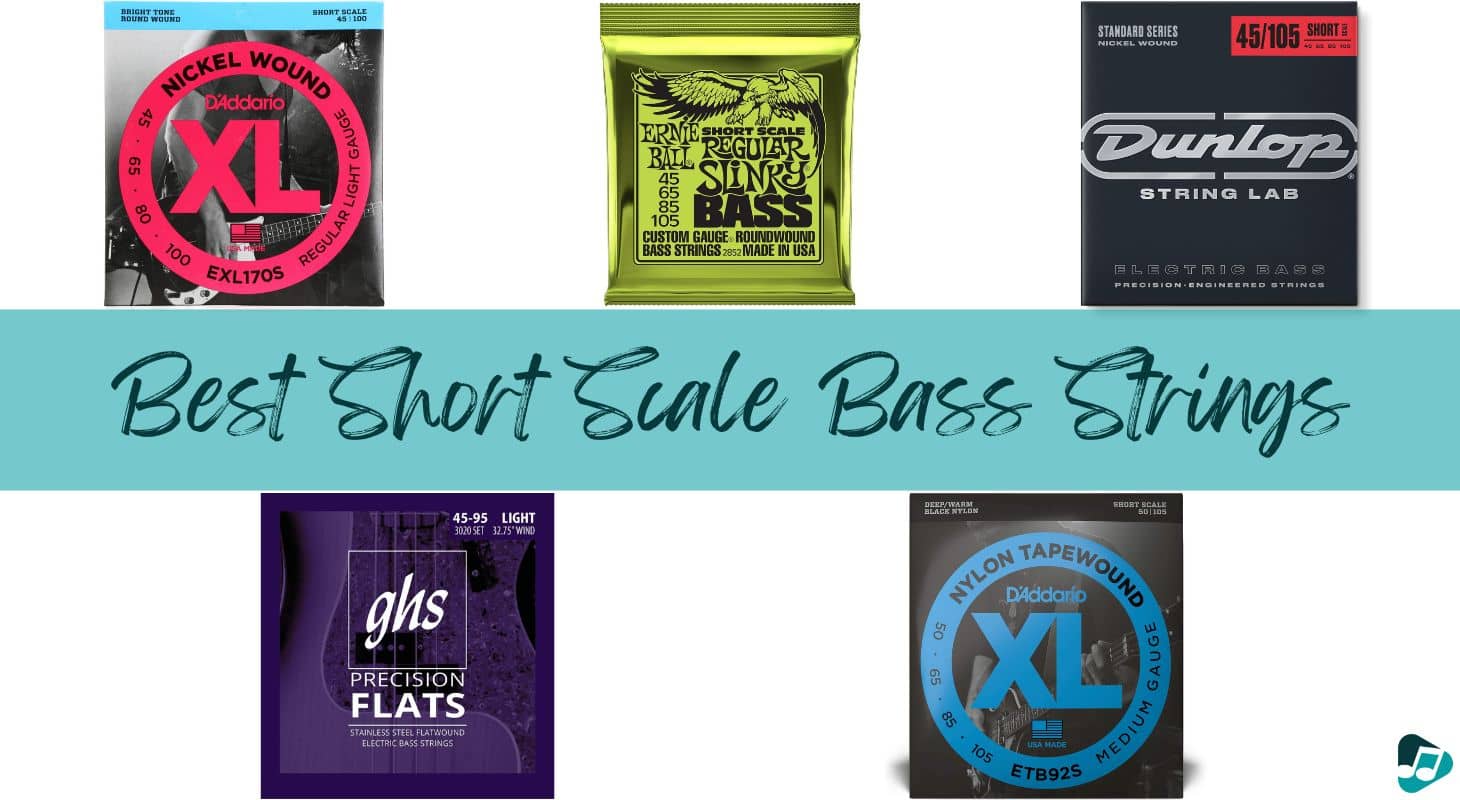
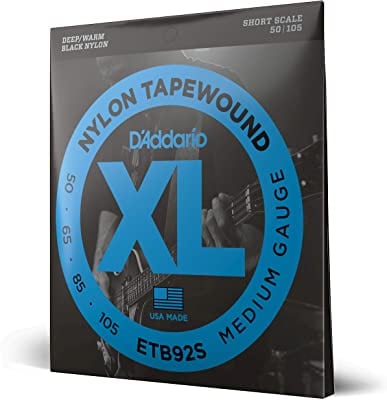
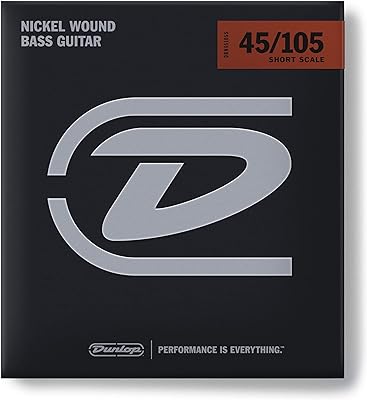
I played a SG Standard Bass for many years. 30.5″ scale and standard long scale bass strings worked great. I can’t seem to get what I need in short scale. I play Funkmasters 30-50-70-90. Fedora ultra light are good to. But now I want a Sterling Ray4SS, 30″ Scale. So I guess I’ll get one and see if these strings work. If they don’t, there are always Custom Shop strings.
The best are La Bella 760FS-S Deep Talkin’ Bass Flatwounds. I’ve been playing 42 years and these are hands down THE best strings I have ever used! I have put them on all 6 of my basses.